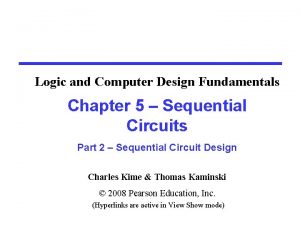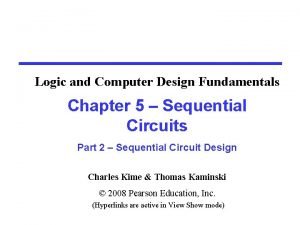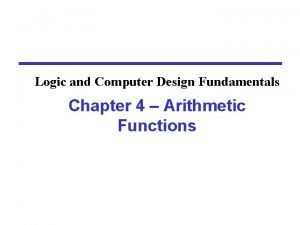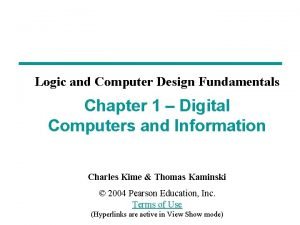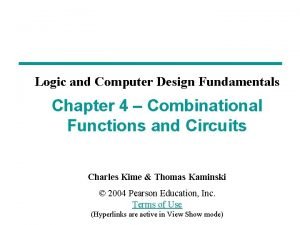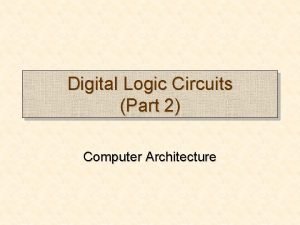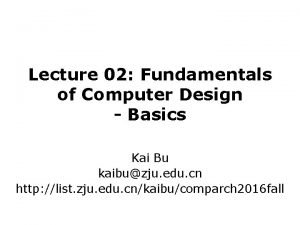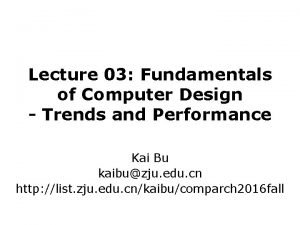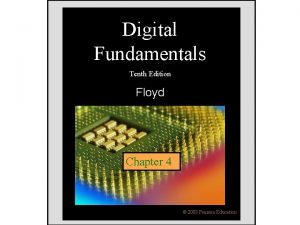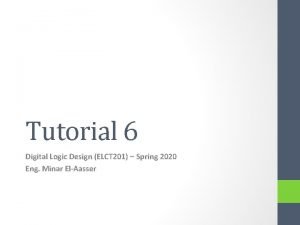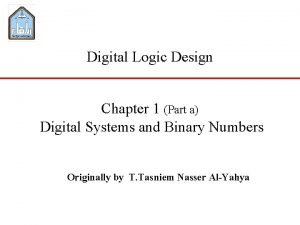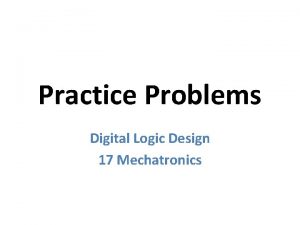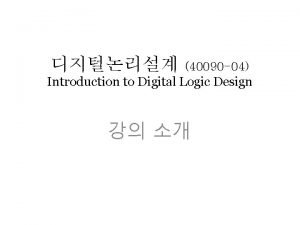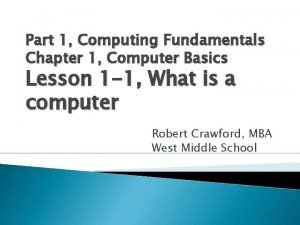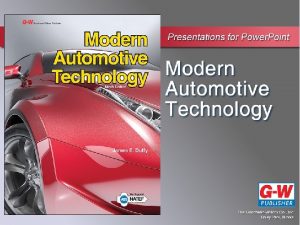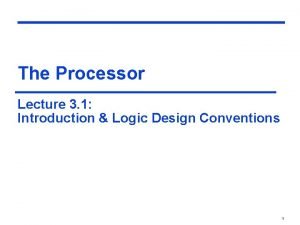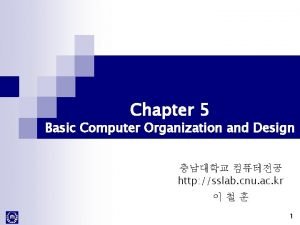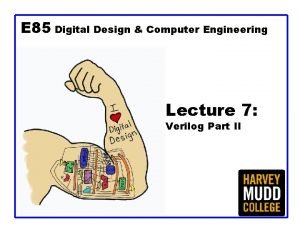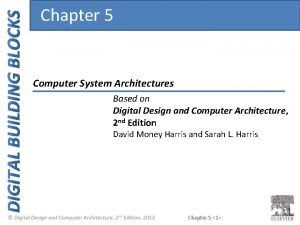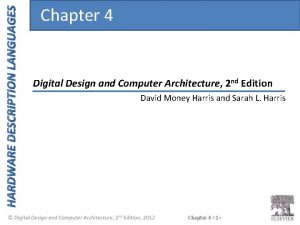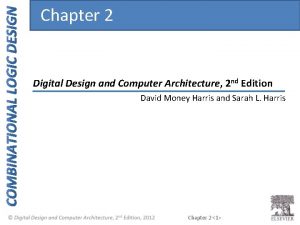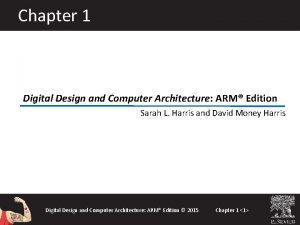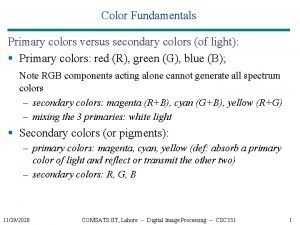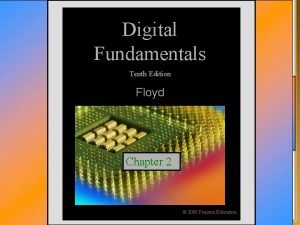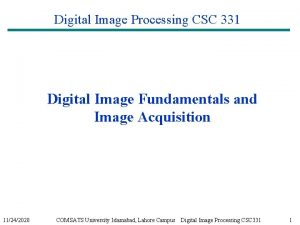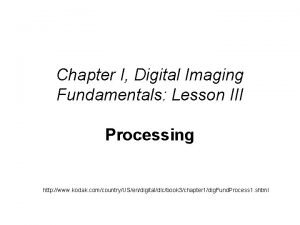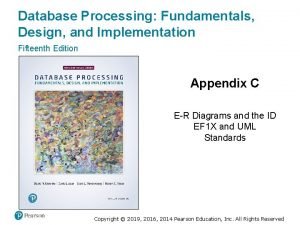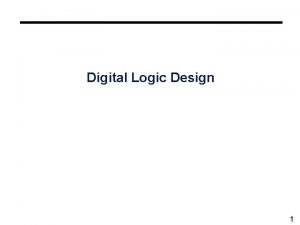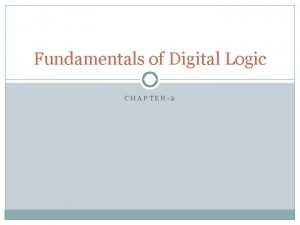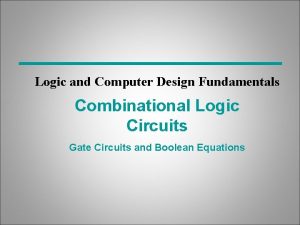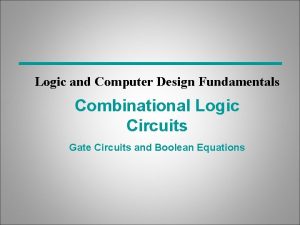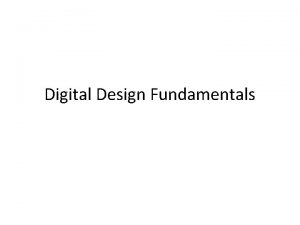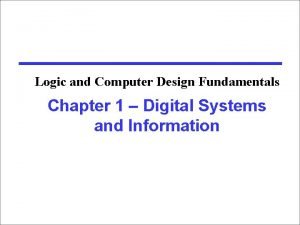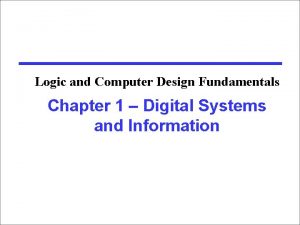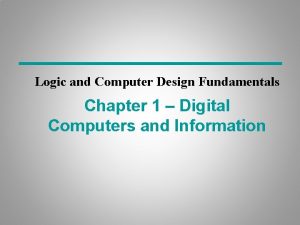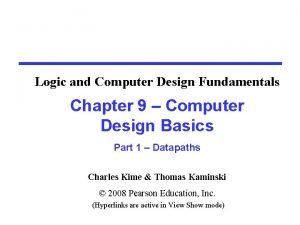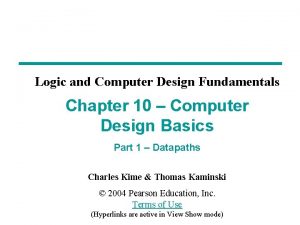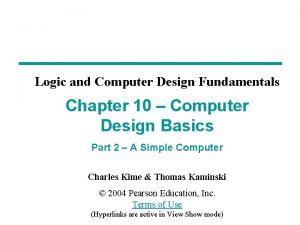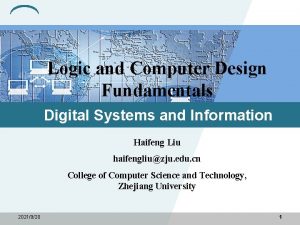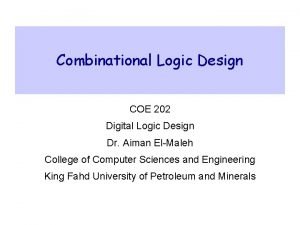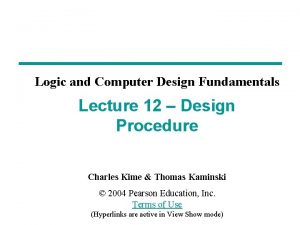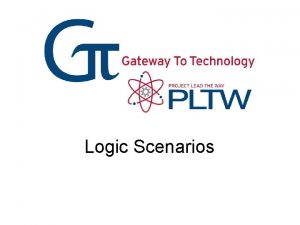Logic and Computer Design Fundamentals Chapter 5 Digital









































- Slides: 41

Logic and Computer Design Fundamentals Chapter 5 – Digital Hardware Implementation Charles Kime & Thomas Kaminski © Pearson Education, Inc.

Overview § The Design Space • Integrated Circuits § Levels of Integration • CMOS Circuit Technology § § CMOS Transistor Models Circuits of Switches Fully Complementary CMOS Circuits Technology Parameters § Programmable Implementation Technologies • • • Why Programmable Logic? Programming Technologies Read-Only Memories (ROMs) Programmable Logic Arrays (PLAs) Programmable Array Logic (PALs) © Pearson Education, Inc. Chapter 5 2

5 -1 The Design Space Integrated Circuits § Integrated circuit (informally, a “chip”) is a semiconductor crystal (most often silicon) containing the electronic components for the digital gates and storage elements which are interconnected on the chip. § Terminology - Levels of chip integration • • SSI (small-scale integrated) - fewer than 10 gates MSI (medium-scale integrated) - 10 to 100 gates LSI (large-scale integrated) - 100 to thousands of gates VLSI (very large-scale integrated) - thousands to 100 s of millions of gates © Pearson Education, Inc. Chapter 5 3

CMOS Circuit Technology MOS Transistor 0 Volts VDD Volts n-Channel Transistor: OFF - no D-to-S Cur rent © Pearson Education, Inc. Chapter 5 4

CMOS Circuit Technology MOS Transistor © Pearson Education, Inc. Chapter 5 5

CMOS Circuit Technology Switch Models for MOS Transistors § n-Channel – Normally Open (NO) Switch Contact § p-Channel – Normally Closed (NC) Switch Contact © Pearson Education, Inc. Chapter 5 6

CMOS Circuit Technology Circuits of Switch Models § Series § Parallel © Pearson Education, Inc. Chapter 5 7

CMOS Circuit Technology Fully-Complementary CMOS Circuit § Circuit structure for fully-complementary CMOS gate © Pearson Education, Inc. Chapter 5 8

CMOS Circuit Technology CMOS Circuit Design Example § Find a CMOS gate with the following function: § Beginning with F 0, and using F § The switch model circuit in terms of NO switches: © Pearson Education, Inc. Chapter 5 9

CMOS Circuit Technology CMOS Circuit Design Example § The switch model circuit for F 1 in terms of NC contacts is the dual of the switch model circuit for F 0: § The function for this circuit is: which is the correct F. © Pearson Education, Inc. Chapter 5 10

CMOS Circuit Technology CMOS Circuit Design Example § Replacing the switch models with CMOS transistors; note input Z must be used. © Pearson Education, Inc. Chapter 5 11

Technology Parameters § Specific gate implementation technologies are characterized by the following parameters: • Fan-in – the number of inputs available on a gate • Fan-out – the number of standard loads driven by a gate output • Logic Levels – the signal value ranges for 1 and 0 on the inputs and 1 and 0 on the outputs (see Figure 1 -1) • Noise Margin – the maximum external noise voltage superimposed on a normal input value that will not cause an undesirable change in the circuit output • Cost for a gate - a measure of the contribution by the gate to the cost of the integrated circuit • Propagation Delay – The time required for a change in the value of a signal to propagate from an input to an output • Power Dissipation – the amount of power drawn from the power supply and consumed by the gate © Pearson Education, Inc. Chapter 5 12

Technology Parameters Fan-out § Fan-out can be defined in terms of a standard load • Example: 1 standard load equals the load contributed by the input of 1 inverter. • Transition time -the time required for the gate output to change from H to L, t. HL, or from L to H, t. LH • The maximum fan-out that can be driven by a gate is the number of standard loads the gate can drive without exceeding its specified maximum transition time © Pearson Education, Inc. Chapter 5 13

Technology Parameters Cost § In an integrated circuit: • The cost of a gate is proportional to the chip area occupied by the gate • The gate area is roughly proportional to the number and size of the transistors and the amount of wiring connecting them • Ignoring the wiring area, the gate area is roughly proportional to the gate input count • So gate input count is a rough measure of gate cost § If the actual chip layout area occupied by the gate is known, it is a far more accurate measure © Pearson Education, Inc. Chapter 5 14

5 -2 Programmable Implementation Technologies Why Programmable Logic? § Facts: • It is most economical to produce an IC in large volumes • Many designs required only small volumes of ICs § Need an IC that can be: • Produced in large volumes • Handle many designs required in small volumes § A programmable logic part can be: • made in large volumes • programmed to implement large numbers of different low-volume designs © Pearson Education, Inc. Chapter 5 15

5 -2 Programmable Implementation Technologies Programmable Logic - More Advantages § Many programmable logic devices are fieldprogrammable, i. e. , can be programmed outside of the manufacturing environment § Most programmable logic devices are erasable and reprogrammable. • Allows “updating” a device or correction of errors • Allows reuse the device for a different design - the ultimate in re-usability! • Ideal for course laboratories § Programmable logic devices can be used to prototype design that will be implemented for sale in regular ICs. • Complete Intel Pentium designs were actually prototyped with specialized systems based on large numbers of VLSI programmable devices! © Pearson Education, Inc. Chapter 5 16

5 -2 Programmable Implementation Technologies Programming Technologies § Programming technologies are used to: • Control connections • Build lookup tables • Control transistor switching § The technologies • Control connections § Mask programming § Fuse § Antifuse § Single-bit storage element © Pearson Education, Inc. Chapter 5 17

5 -2 Programmable Implementation Technologies Programming Technologies § The technologies (continued) • Build lookup tables § Storage elements (as in a memory) • Transistor Switching Control § Stored charge on a floating transistor gate • Erasable • Electrically erasable • Flash (as in Flash Memory) © Pearson Education, Inc. Chapter 5 18

5 -2 Programmable Implementation Technologies Technology Characteristics § Permanent - Cannot be erased and reprogrammed § Mask programming § Fuse § Antifuse § Reprogrammable • Volatile - Programming lost if chip power lost § Single-bit storage element • Non-Volatile § Erasable § Electrically erasable § Flash (as in Flash Memory) © Pearson Education, Inc. Chapter 5 19

5 -2 Programmable Implementation Technologies The symbols © Pearson Education, Inc. Chapter 5 20

5 -2 Programmable Implementation Technologies Programmable Configurations § Read Only Memory (ROM) - a fixed array of AND gates and a programmable array of OR gates § Programmable Array Logic (PAL)Ò - a programmable array of AND gates feeding a fixed array of OR gates. § Programmable Logic Array (PLA) - a programmable array of AND gates feeding a programmable array of OR gates. § Complex Programmable Logic Device (CPLD) /Field. Programmable Gate Array (FPGA) - complex enough to be called “architectures © Pearson Education, Inc. PAL is a registered trademark of Lattice Semiconductor Corp. Chapter 5 21

5 -2 Programmable Implementation Technologies ROM, PAL and PLA Configurations © Pearson Education, Inc. Chapter 5 22

Read-Only Memory Read Only Memory § Read Only Memories (ROM) or Programmable Read Only Memories (PROM) have: • N input lines, • M output lines, and • 2 N decoded minterms. § Fixed AND array with 2 N outputs implementing all N-literal minterms. § Programmable OR Array with M outputs lines to form up to M sum of minterm expressions. © Pearson Education, Inc. Chapter 5 23

Read-Only Memory Read Only Memory § A program for a ROM or PROM is simply a multiple-output truth table • If a 1 entry, a connection is made to the corresponding minterm for the corresponding output • If a 0, no connection is made § Can be viewed as a memory with the inputs as addresses of data (output values), hence ROM or PROM names! © Pearson Education, Inc. Chapter 5 24

ROM © Pearson Education, Inc. Chapter 5 25

Read-Only Memory Read Only Memory Example § Example: A 8 X 4 ROM (N = 3 input lines, M= 4 output lines) § The fixed "AND" array is a X X X D 7 D 6 “decoder” with 3 inputs and 8 X X D 5 X outputs implementing minterms. D 4 A 2 D 3 X § The programmable "OR“ A D 2 X X A 1 D 1 array uses a single line to B X A 0 D 0 C represent all inputs to an OR gate. An “X” in the array corresponds to attaching the minterm to the OR F 0 F 2 F 1 F 3 § Read Example: For input (A 2, A 1, A 0) = 001, output is (F 3, F 2, F 1, F 0 ) = 0011. § What are functions F 3, F 2 , F 1 and F 0 in terms of (A 2, A 1, A 05)? © Pearson Education, Inc. Chapter 26

Programmable Logic Array (PLA) § Compared to a ROM and a PAL, a PLA is the most flexible having a programmable set of ANDs combined with a programmable set of ORs. § Advantages • A PLA can have large N and M permitting implementation of equations that are impractical for a ROM (because of the number of inputs, N, required • A PLA has all of its product terms connectable to all outputs, overcoming the problem of the limited inputs to the PAL Ors • Some PLAs have outputs that can be complemented, adding POS functions © Pearson Education, Inc. Chapter 5 27

Programmable Logic Array (PLA) § Disadvantages • Often, the product term count limits the application of a PLA. • Two-level multiple-output optimization is required to reduce the number of product terms in an implementation, helping to fit it into a PLA. • Multi-level circuit capability available in PAL not available in PLA requires external connections to do multi-level circuits. © Pearson Education, Inc. Chapter 5 28

Programmable Logic Array Example § What are the equations for F 1 and F 2 ? © Pearson Education, Inc. Chapter 5 29

Programmable Array Logic Devices Programmable Array Logic (PAL) § The PAL is the opposite of the ROM, having a programmable set of ANDs combined with fixed ORs. § Disadvantage • ROM guaranteed to implement any M functions of N inputs. PAL may have too few inputs to the OR gates. § Advantages • For given internal complexity, a PAL can have larger N and M • Some PALs have outputs that can be complemented, adding POS functions • No multilevel circuit implementations in ROM (without external connections from output to input). PAL has outputs from OR terms as internal inputs to all AND terms, making implementation of multi-level circuits easier. © Pearson Education, Inc. Chapter 5 30

Programmable Array Logic Devices Programmable Array Logic Example © Pearson Education, Inc. Chapter 5 31

© Pearson Education, Inc. Chapter 5 32

Field Programmable Gate Array While FPGA devices from different manufacturers have a wide variety of features, most FPGA devices have three programmable elements in common: • programmable logic block • programmable interconnect • programmable input/output pins © Pearson Education, Inc. Chapter 5 33

Programmable logic block § © Pearson Education, Inc. Chapter 5 34

Programmable logic block § A 2 -input LUT § Sixteen possible Boolean functions can be implemented Fig. 5 -12 © Pearson Education, Inc. Chapter 5 35

Programmable logic block • To implement functions more than k variables, several k-LUTs can be connected together with multiplexers • Shannon’ expansion theorem Fig. 5 -12 © Pearson Education, Inc. Chapter 5 36

Programmable logic block © Pearson Education, Inc. Chapter 5 37

Programmable logic block In addition to LUT, there are § Multiplexers § Flip-flops § Other logic to configure the block to implement a wide variety of functions © Pearson Education, Inc. Chapter 5 38

Programmable logic block § An example There is a set of SRAM configuration bits denoted by squares numbered from 0 to 10. © Pearson Education, Inc. Chapter 5 39

Programmable interconnection § is made up of a set of wires and programmable switches § programmable switches usually consists of a single n-channel MOS transistor © Pearson Education, Inc. Chapter 5 40

Programmable input/output (I/O) pins § The FPGA must be connected with the outside world § Must be compatible with the speed and voltage requirements of the other electrical components to which it will be connected. § Most FPGAs provide a large number of pins that can be configured to support a number of different electrical interface standards. © Pearson Education, Inc. Chapter 5 41
 Jk flip flop
Jk flip flop Jk flip flop
Jk flip flop Logic and computer design fundamentals
Logic and computer design fundamentals Logic and computer design fundamentals
Logic and computer design fundamentals Logic & computer design fundamentals
Logic & computer design fundamentals Digital logic and computer architecture
Digital logic and computer architecture Fundamentals of computer design
Fundamentals of computer design Fundamentals of computer design
Fundamentals of computer design Digital fundamentals chapter 4
Digital fundamentals chapter 4 Digital logic design tutorial
Digital logic design tutorial Digital logic design number system
Digital logic design number system Digital logic design practice problems
Digital logic design practice problems Digital logic design lectures
Digital logic design lectures Digital logic design
Digital logic design Computer fundamentals chapter 1
Computer fundamentals chapter 1 Chapter 23 computer system fundamentals
Chapter 23 computer system fundamentals Lllqq
Lllqq Common bus system for 4 registers
Common bus system for 4 registers Digital design and computer architecture arm edition
Digital design and computer architecture arm edition Digital design and computer architecture
Digital design and computer architecture Digital design and computer architecture
Digital design and computer architecture Digital design and computer architecture
Digital design and computer architecture Bubble pushing example
Bubble pushing example Digital design and computer architecture arm edition
Digital design and computer architecture arm edition First order logic vs propositional logic
First order logic vs propositional logic First order logic vs propositional logic
First order logic vs propositional logic First order logic vs propositional logic
First order logic vs propositional logic Combinational logic vs sequential logic
Combinational logic vs sequential logic Cryptarithmetic problem logic+logic=prolog
Cryptarithmetic problem logic+logic=prolog Software development plan
Software development plan Majority circuit
Majority circuit Combinational logic sequential logic 차이
Combinational logic sequential logic 차이 Logic chapter three
Logic chapter three Digital fundamentals floyd ppt
Digital fundamentals floyd ppt Digital fundamentals 10th edition floyd
Digital fundamentals 10th edition floyd Color fundamentals in digital image processing
Color fundamentals in digital image processing Floyd digital fundamentals ppt
Floyd digital fundamentals ppt Digital fundamentals answers
Digital fundamentals answers Image processing
Image processing Fundamentals of digital imaging
Fundamentals of digital imaging Database processing fundamentals design and implementation
Database processing fundamentals design and implementation Basic computer organization
Basic computer organization
